



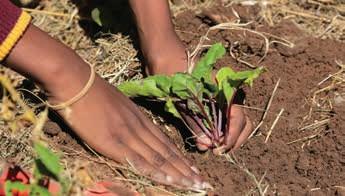

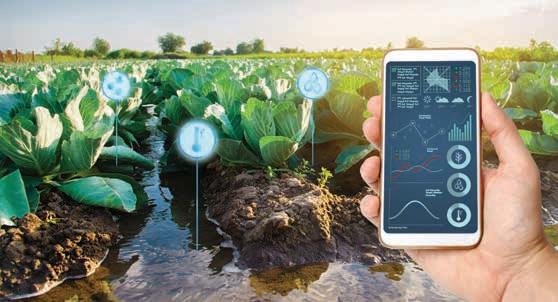







WORLD FOOD DAY WWW.BUSINESSMEDIAMAGS.CO.ZA 16 OCTOBER 2022 LAND TENURE CRITICAL FOR FOOD PRODUCTION INSIDE: HOME GARDENS TO REDUCE HUNGER • CAN URBAN TECH SAVE OUR RURAL COMMUNITIES? • STILL TOO MUCH FOOD WASTE

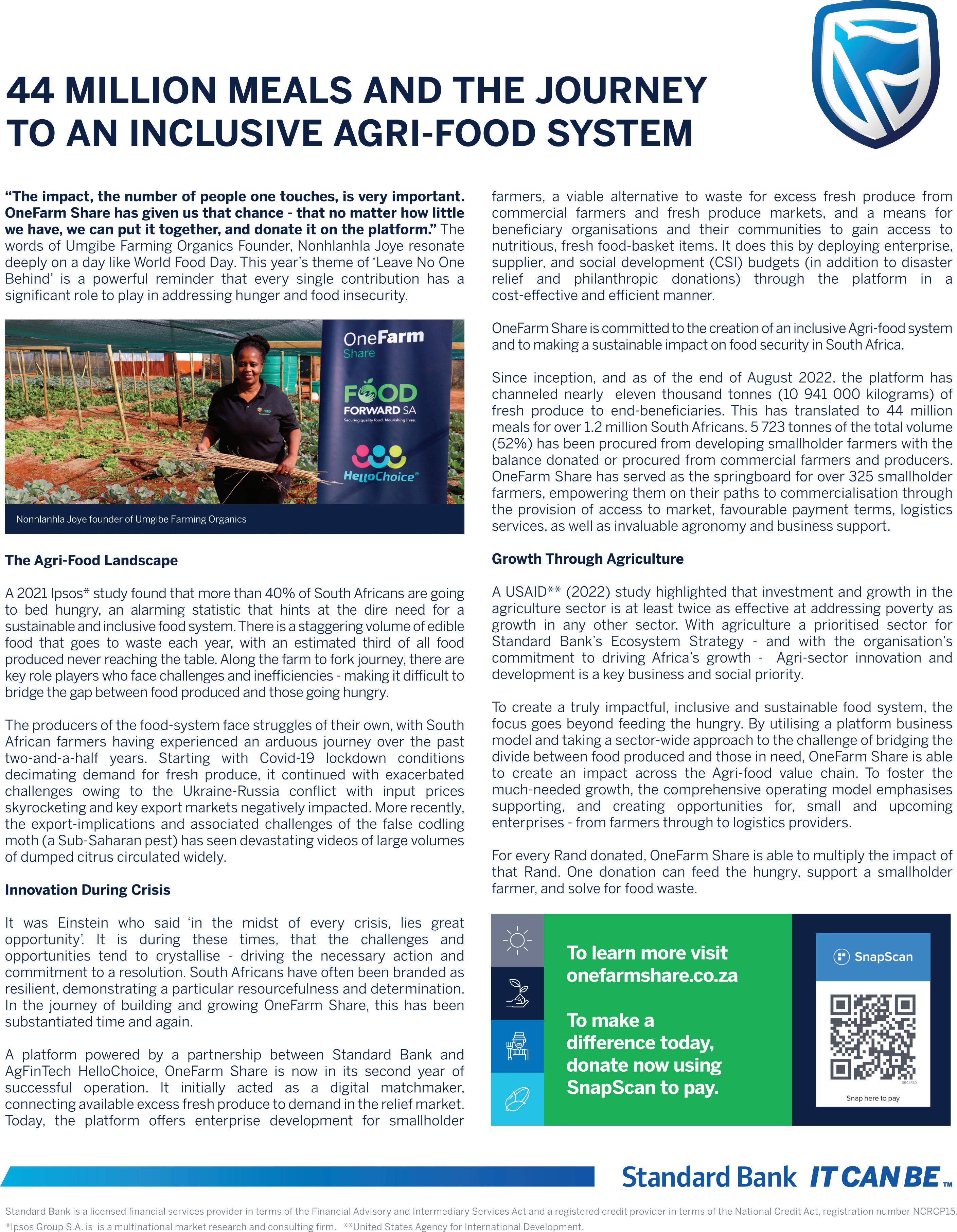
www.businessmediamags.co.za
Anyone who has had to tackle the day’s tasks with the pang of hunger can fathom, at least partly, what one in every nine people worldwide experience every day. In South Africa, this number is one in six, and has presumably risen since COVID-19 wreaked havoc on our economy.
The complexity of factors that ensures food security in a nation makes this problem so hard to solve. How do we get excess food to communities where there is none? How do we create jobs that will put food on the table? How do we capitalise on rich agricultural lands that lie fallow in South Africa’s former homelands? In this year’s publication for World Food Day, we grapple with these questions.
South Africa’s ability to produce food is quite remarkable considering that we are classified as a dry country, with large parts being semi-desert. Climate change is thus a major threat. Rainfall is expected to taper down in coming years, and that which does fall is expected to be more erratic and prone to cause flooding.
With such erratic weather come pests and diseases that erode yields. In a world that has reached its fill for chemical-laden crops, the


solution lies in better technologies that will boost the genetic potential and resilience of plants in such a way that they can withstand environmental stresses. Yet in this solution lies another hurdle: public acceptance of new technology. Whereas southern Africa is touted as being ground zero for the implementation of technology that will see continued food production amid climate disruptions, this is also the region where adoption of technology has been slowest. The politicising of genetic modification of seeds has meant that Africa has for the most part shunned the very seeds that could double its harvests.
Now, with the advent of genome-edited seeds, the continent has another opportunity to embrace food security through the adoption of a new technology. Here, scientific evidence needs to prevail over fake news and unsubstantiated anecdotes.
Food security is an issue so complex, requiring intervention on multiple levels of society, that solutions are hard come by. Grabbing low-hanging fruit in the form of available technology, open and fertile fields, and land tenure should be our top priority.
Published by:
6 FOOD SECURITY
Unpacking the biggest challenges to South Africa’s food security
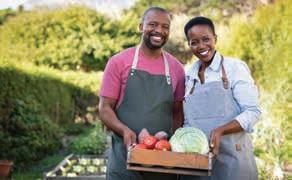
7 THOUGHT LEADERSHIP: JOB CREATION
How boosting job creation in the former homelands is key to reducing food insecurity
LAND TENURE
Land tenure is critical for consistency in food production
16 THOUGHT LEADERSHIP: SUBSISTENCE FARMING
What must be done to close the yield gap with commercial farming
19 THOUGHT LEADERSHIP: TECHNOLOGY
Could urban technology save marginalised rural communities?
22 FOOD WASTE
Identifying the points in the food value chain that are responsible for the most food waste
27 SUSTAINABLE DIETS

Eschewing animal proteins may not be the best way forward
PIcasso Headline, a proud division of Arena Holdings (Pty) Ltd Hill on Empire, 16 Empire Road (cnr Hillside Road), Parktown, Johannesburg, 2193 PO Box 12500, Mill Street, Cape Town, 8010 www.businessmediamags.co.za

EDITORIAL
Editor: Lindi Botha
Content Manager: Raina Julies rainaj@picasso.co.za
Contributors: Busani Bafana, Colleen Dardagan, Denene Erasmus, Hamlet Hlomendlini, Mmatlou Kalaba, Mbali Nwoko, Wandile Sihlobo
Copy Editor: Anthony Sharpe

Content Co-ordinator: Vanessa Payne
Digital Editor: Stacey Visser vissers@businessmediamags.co.za
DESIGN
Head of Design: Jayne Macé-Ferguson
Senior Designer: Mfundo Archie Ndzo
Advert Designer: Bulelwa Sotashe
Cover images: Istock.com/ Ridofranz, Istock.com/ Drazen Zigic, Istock.com/ Andrii Yalanskyi, Istock.com/ Sunshine Seeds
SALES
Project Manager: Jerome van der Merwe jeromev@picasso.co.za | +27 21 469 2485 +27 820 668 1496
Sales: Frank Simons
PRODUCTION
Production Editor: Shamiela Brenner
Advertising Co-ordinator: Johan Labuschagne
Subscriptions and Distribution: Fatima Dramat, Fatimad@picasso.co.za
Printed: CTP Printers, Cape Town
MANAGEMENT
Management Accountant: Deidre Musha
Business Manager: Lodewyk van der Walt General Manager, Magazines: Jocelyne Bayer
COPYRIGHT: No portion of this magazine may be reproduced in any form without written consent of the publisher. The publisher is not responsible for unsolicited material. World Food Day is published by Picasso Headline. The opinions expressed are not necessarily those of Picasso Headline. All advertisements/advertorials have been paid for and therefore do not carry any endorsement by the publisher.

2 WORLD FOOD DAY FROM THE EDITOR
13
Contents
16
FOOD SECURITY IS COMPLEX, BUT THERE ARE GAINS TO BE MADE
27
Lindi Botha

DRIVING GROWTH POST THE PANDEMIC
Between COVID-19-related lockdowns and the war in Ukraine, the last two years have delivered massive economic challenges. Food security issues, in particular, have been magnified as disruptions in supply chains triggered massive price hikes in staple food.
Ukraine, for instance, accounts for 42 per cent of global sunflower oil production, 16 per cent of global wheat exports, 8.9 per cent of global wheat supply, and 9.7 per cent of the global barley crop. After the invasion at the end of February, prices of these commodities surged.
There are renewed efforts to boost internal production in countries relying on Ukrainian and Russian exports. These efforts have, however, been hampered by the cost and availability of the fertiliser. In countries such as Brazil, Argentina, and Bangladesh, which rely on Russia for meeting a substantial share of
their fertiliser needs, high fertiliser prices and lower production over the medium term could result in high staple commodity costs over the medium term.
Africa, in turn, accounts for three to four per cent of global fertiliser consumption. Despite this modest share, these high prices could also lead to lower applications and yields and result in lower production and higher internal prices.
South Africa specifically imports around 80 per cent of its fertilisers from Russia, according to the Fertiliser Association of South Africa. In the past two years, international fertiliser prices have increased due to several factors, including low stock levels caused by the COVID-19 pandemic, high natural gas prices, and the Russia and Ukraine crisis, according to the National Agricultural Marketing Council. In June, the Council noted that from May 2021 to May 2022, international prices
Energy and electricity are also key from the food production and processing perspective and therefore need to be present to ensure safe, healthy and affordable food production.
(Rand terms) for muriate of potash, di-ammonium phosphate and urea increased by 303.8 per cent, 119.5 per cent and 78.0 per cent, respectively. During the same period, the R/$ exchange rate depreciated by 13.2 per cent from R/$14.04 to R/$15.89.
With countries in Africa more at risk in terms of food security than in the developed world, there’s an urgent and permanent need to enable food production and processing on the continent. Here the question becomes what can be done to enable this, given the current challenges of high input costs and supply chain issues as discussed above. Although not exhaustive, we believe the three fundamental issues could contribute to the solution.
LEVERAGING ON THE REGION’S ENERGY DEFICIT FOR INVESTMENT IN GREEN ENERGY
According to the World Bank, although global access to electricity has increased over the past decade, the number of people without access to electricity in sub-Saharan Africa decreased. Energy and electricity are also key from the food production and processing perspective and therefore need to be present to ensure safe, healthy and affordable food production.
Investment in green energy provides solutions for countries with current energy deficits to produce sufficient energy and leap from conventional energy solutions to renewable sources to supplement the aforementioned deficit.

4 WORLD FOOD DAY
Simplification of trade and a focus on sustainability can drive Africa’s post-COVID-19 growth, write ROUX WILDENBOER and MARLENE LOUW, head of agriculture and senior agricultural economist, Absa Group.
ADVERTORIAL ABSA CIB
Climate fi nancing has a key role to play in funding renewable solutions and innovations that support climate goals, and commercial banks around the globe have made great strides in this. In recent years, several new methods for fi nancing green projects have been developed, including green bonds, green banks, and village funds.
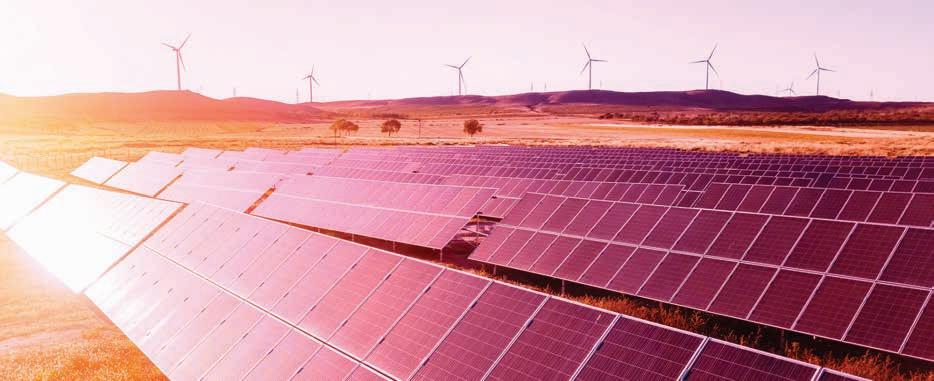
Financiers engaging in green fi nancing have a vital role in channelling capital or extending credit to environmental initiatives. Ways to achieve this could include offering better credit conditions for clean energy projects, the creation of innovative fi nancial products that reward producers with good environmental practices, and market expansion through the dissemination of information about the benefi ts of clean energy. In this regard, Absa is also geared to support renewable energy projects in South Africa and beyond.
POLICY CONSIDERATIONS TO ENHANCE INVESTMENT
All African governments interested in increasing agricultural production need to review their policy environments in terms of import and export quotas, tariff barriers, and the fl ow of skilled workers. Many governments want local employment quotas to apply right from the start, which could make investment unattractive.
There are also policy issues around the continent that are contributing to supply chain bottlenecks, which are, in turn, constraining investment and limiting trade. African countries that are proponents of the free market model
are typically the ones where the strongest growth in trade and agriculture investment have taken place. Countries such as Ivory Coast, Rwanda, Tanzania, and Kenya have seen a lot of interest from offshore investors recently, with these governments taking steps to make their economies more investor-friendly.
Within this context, governments should create a conducive policy environment where business and trade can thrive. This would include limiting red tape, prosecuting corruption, and removing administrative delays, all of which will contribute to the feasibility of investment.
CREATING AN ENABLING ENVIRONMENT FOR TRADE
Some of the policy issues above also affect intraregional trade. Take potato trade from South Africa as an example. There’s a strong need for potatoes and related products in central and southern Africa, which can, at least in part, be serviced by potato volumes from South Africa. Transport times and border delays, however, often lead to a deterioration in quality and an increase in price, which ultimately renders the product delivered in-country inaccessible to consumers in the importing country.
The agreement that will establish the African Continental Free Trade Area (AfCFTA) holds promise in this area, but it needs to be implemented effectively and uniformly. Some issues show that despite established trade agreements, African governments are still implementing trade barriers impulsively. This is often underpinned by protectionist arguments with a continuous trade-off between “protecting”
and developing local industries. Here, for example, is the current block from Botswana and Namibia on tomatoes, potatoes, and onions from South Africa to protect their local infant industries. Unfortunately, trade bans are detrimental to lowering costs and increasing production, for the region as a whole, over the long run.
Attracting investment into a country’s food sector and creating an enabling environment for trade can go a long way in creating long-term food security. This can often be achieved through government initiatives such as tax breaks, but these are difficult to establish in many African countries because so many operate with a budget deficit. In this regard, promoting investment and trade via market-friendly regulation could have a major impact. Investment into renewable energy, in turn, has an important role to play in unlocking value and alleviating bottlenecks in food production and processing across the region.
this QR code to go directly to the Absa CIB website.

For more information: www.cib.absa.africa www.twitter.com/Absa_CIB/ http://www.linkedin.com/showcase/absa-cib/

WORLD FOOD DAY 5 ➔ Scan
All African governments interested in increasing agricultural production need to review their policy environments in terms of import and export quotas, tariff barriers, and the flow of skilled workers.
IMAGES: SUPPLIED
ABSA CIB ADVERTORIAL
South Africa’s food security paradox
Despite having the largest economy in the region, South Africa’s level of food insecurity is roughly on par with the regional trend for southern Africa, where the share of undernourished people increased from 21 per cent in 2019 to over 25 per cent in 2020, according to the World Bank.
The most recent survey available from Statistics South Africa shows that about 23.6 per cent of South Africans are affected by moderate to severe food insecurity, while almost 14.9 per cent experience severe food insecurity.
A lthough there are many factors, high inequality, unemployment and persistent income poverty are structural causes that drive malnutrition in the country. At around 35 per cent, South Africa has one of the highest unemployment rates in the world, which explains to some extent why it is the most unequal society in the world and why about 27 per cent of people live in extreme poverty.
Unpacking the paradox
Prof Julian May, director of the Centre for Excellence in Food Security, refers to a recent food system profile of South Africa that the centre published this year in collaboration with the Food and Agriculture Organization of the United Nations (FAO) and the European Union. The report describes South Africa’s food system as a paradox.
“We should achieve better outcomes, but we don’t,” says Prof May. “We produce enough food, and have the resources and scientific expertise to be a net exporter of food, yet the food system output is poor,
FAST FACT
Despite nearly a quarter of South Africans experiencing high levels of food insecurity, 68 per cent of women and 31 per cent of men are overweight or obese.
Source: South Africa Demographic and Health Survey
Erratic weather in coming years could severely impact crop yields.

with high levels of obesity and about a quarter of children malnourished.”
The report says that another driver of food insecurity and malnutrition is the price of healthy foods compared to highly processed foods. The average national intake of fruit and vegetables is 200g per person per day – half the World Health O rganization’s recommendation.
Access to basic services such as electricity and clean, running water also has an impact on household level food security, says Prof Sheryl Hendriks of the University of Pretoria. A bout 85 per cent of the population have access to electricity, and 88 per cent have access to tapped water, but the quality and consistency of delivery of electricity, water and sanitation is a concern. “Most highly nutritious food, such as fruit, vegetables, and animal proteins, requires refrigeration for storage. If there is no access to electricity, it is difficult for a household to have access to these foods.”
Prof Hendriks agrees that one of the leading causes of food insecurity is low income. “The situation has been made worse by the impact of the COVID-19 pandemic

and more recently by high inflation. In March the FAO’s food price index reached a new all-time high, as factors such as the Russian invasion of Ukraine and drought conditions in key agricultural production regions saw the prices of products such as vegetable oil and wheat rise to record levels.”
Key interventions
Interventions such as increasing the Child Support Grant and making healthy food more accessible can play a role in improving the situation, but to increase food security significantly, the country’s economy needs to grow and create jobs, says Prof Hendriks. Social grants, which many low-income and unemployed South Africans rely on, “help to keep the wolf from the door”, but are not sufficient to help people really improve their lives by creating a source of income for themselves, she says.
One solution Prof Hendriks suggests would be to increase access to capital for low-income earners. This has been done successfully in other countries: the Grameen Bank is a micro-finance organisation and community development bank founded in Bangladesh that makes small loans to the impoverished without requiring collateral.
There are also successful programmes run by agriculture commodity organisations in South Africa that could be expanded or replicated, adds Prof Hendriks. One of these is the Grain SA Farmer Development Programme which helps small-scale farmers increase grain yields by giving them access to better inputs and teaching them improved farming techniques.
programmes are particularly effective in rural areas where many families rely on some form of farming to supplement their income and access to food.
Prof Sheryl Hendriks

6 WORLD FOOD DAY FOOD SECURITY IMAGES: ISTOCK.COM/ LEX20 , S UPPL IE D
DENENE ERASMUS unpacks the biggest challenges to putting food on the plates of all South Africans
“We produce enough food, and have the resources and scientific expertise to be a net exporter of food, yet the food system output is poor, with high levels of obesity and about a quarter of children malnourished.” – Prof Julian May
Prof Julian May
The past three years have reversed some countries’ gains in boosting food security. As some people lost their jobs at the height of COVID-19, it became harder to afford a balanced food basket than in the pre-pandemic years. Global agricultural prices also increased due to disruptions in supply chains and higher shipping costs. Moreover, the drought in South America, and China’s continual restocking of grains and oilseeds contributed to driving up global food prices.
In this already fragile global food security environment, the Russia-Ukraine war started at the end of February 2022, driving food prices even higher. The Food and Agriculture Organization of the United Nations, in its State of Food Security and Nutrition in the World 2021 report, notes that between 720 million and 811 million people in the world faced hunger in 2020. This number will only have increased in 2022 due to war-induced higher food prices. Asia and Africa have the largest number of malnourished regions, and are most exposed to grain imports.
A good agricultural position
South Africa sits in a relatively better position than many countries. We have a vibrant agricultural sector, ensuring that we remain net exporters of agricultural and food products. In 2021, as hunger and food scarcity increased in other regions, South Africa exported a record volume and value of agricultural and food products, amounting to R212.5-billion. In value terms, the country exports roughly half its agricultural and food products a year.
Agriculture as a large-scale employer
Chief economist of the Agricultural Business Chamber of South Africa, WANDILE SIHLOBO, discusses how boosting job creation in the former homelands is key to reducing food insecurity
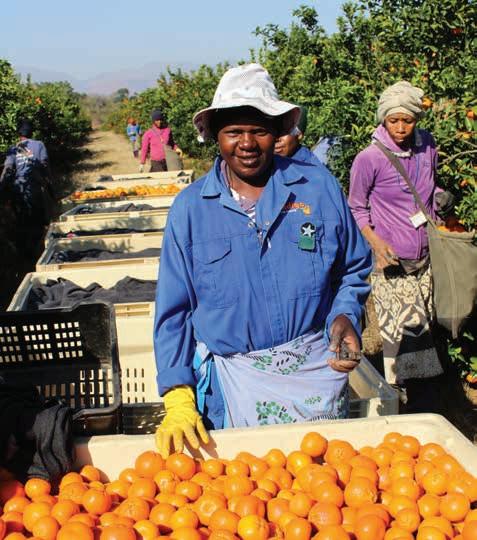

Moreover, in measurements such as the Global Food Security Index, South Africa is ranked as the most food-secure country in the sub-Saharan Africa region. The Global Food Security Index comprises four sub-indices, namely: food affordability, food availability, food quality and safety, and natural resources and resilience. The affordability and availability sub-indices combined have a higher weighting of two-thirds (each 32.4 per cent).
The affordability sub-index includes a change in average food costs, proportion of a population in poverty and agricultural import tariffs. Meanwhile, the availability sub-index consists of the sufficiency of supply, agricultural infrastructure, volatility in agricultural production, political and social barriers to food, and food loss.
In 2021, South Africa experienced a mild deterioration in the food affordability and availability sub-indices of 0.7 and 0.1 points, respectively. Meanwhile, the rest of the sub-indices improved marginally. In the case of affordability, the major challenge was an overall increase in food prices. This is aligned with the general rise in global food prices mentioned earlier.
Unemployment drives food insecurity
While South Africa had a good agricultural season, which saw an increase in exports, domestic food prices did not respond by slowing their increase. This
In 2021, as hunger and food scarcity increased in other regions, South Africa exported a record volume and value of agricultural and food products, amounting to R212.5-billion.
Wandile Sihlobo
is primarily because of the interlinked nature of domestic food commodities and the global environment. Notably, the challenge of rising food prices also arose when people were out of work as the pandemic forced many businesses to close.
Recent statistics suggest that approximately 11 per cent of South Africa’s population are food insecure, mainly people living in Limpopo, Eastern Cape and KwaZulu-Natal. Affordability is a major issue. Still, this does not mean food in South Africa is necessarily more expensive than in other regions; the challenge is the lack of household incomes and higher unemployment.
For this job creation challenge, agriculture should receive priority. But the focus should not only be on viewing agriculture as a sector for boosting household food security through community gardens alone, but also on utilising this sector for large-scale employment while solving regional food-security challenges.
Fortunately, at a technical level, the ideas of expanding agriculture and agro-processing capacity to boost growth and job creation were well established as far back as the publication of the National Development Plan in 2012, with chapter six focusing on this sector. These include expanding agricultural activity in the former homelands and on government land, enhancing government-commodity organisations’ partnerships in extension services, and investing in the network industries (water, electricity and road infrastructure), port infrastructure, and state laboratories. With a commercial focus where conditions permit, agricultural improvement could help job creation and household food security.
THOUGHT LEADERSHIP – JOB CREATION IMAGES: S UPPL IE D WORLD FOOD DAY 7
While South Africa is ranked as the most food-secure country in the sub-Saharan Africa region, not everyone has access to this food.







On World Food Day Nedbank stresses the need for food security in SA




World Food Day, an international day celebrated on 16 October, focuses on tackling global hunger and eradicating hunger across the world. Millions of people can’t afford a healthy diet, putting them at high risk of food insecurity and malnutrition.
Food is a human right, yet approximately 11% of South Africa’s population (6,5 million people) is hungry and food-insecure. As part of Nedbank’s commitment to the United Nations Sustainable Development Goals (SDGs), it funds economic and social development initiatives in rural and suburban communities to drive sustainable development and a green economy.
‘Food is one the basic needs of a healthy human, along with water and shelter,’ says Poovi Pillay, Executive Head for Nedbank Corporate Social Investment (CSI). ‘It is essential for every person to survive and thrive, yet we are in the midst of a food security crisis. Despite all the world’s resources, food security or reliable access to enough affordable and nutritious food, is a pressing issue – not only in South Africa, but around the world. Food security has an impact on the health of children and adults, and is challenged by rapid climate change and agricultural obstacles. At Nedbank, we are playing our part as a responsible corporate citizen by funding various key agricultural projects that will help feed the most vulnerable in our country.’
These farmers have completed SETA-accredited courses in agricultural training and are building their smallholder enterprises into proper business ventures. The project supports farmers through skills development, coaching, mentoring and start-up support. By creating an enabling environment in this start-up phase, this project will support the readiness of farmers to start engaging commercially or semi-commercially.
The transformation of subsistence farming into commercial businesses is a key focus area of Nedbank’s CSI efforts. The bank supports several agricultural projects that enhance the business performance of farms, create employment opportunities, maximise their involvement in the food value chain and contribute to local economic development and food security in their communities.
Since 2018 Nedbank has collaborated with Buhle Farmers Academy to implement a farmer development programme in the Vuwani area in Limpopo. The project consists of 10 emerging-farming businesses, with each farmer employing five workers.
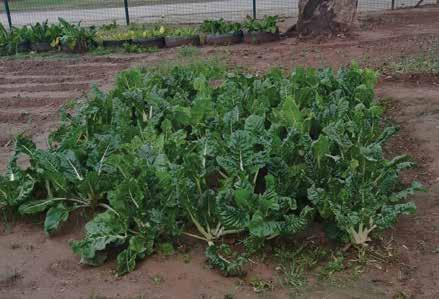
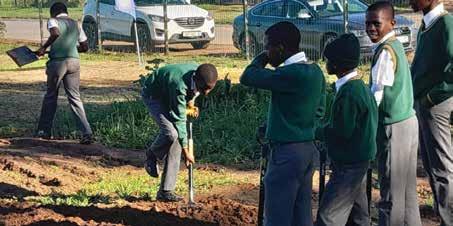
Indirect beneficiaries include hawkers who buy vegetables to resell to the community, family members of farmers and their employees, and those who buy vegetables for agricultural processing.

Nedbank also supports Reel Life, the non-profit arm of Reel Gardening that has been actively involved in the agricultural space since 2009. With the support of corporates, Reel’s take-home household garden kits have been provided to more than 20,5 million households across South Africa.
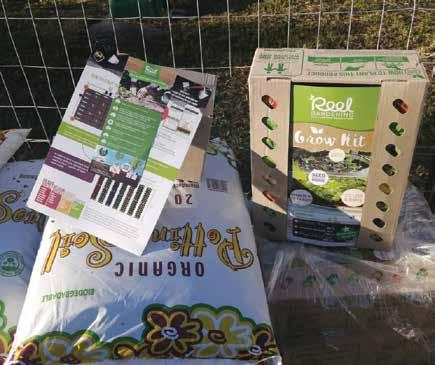
Nedbank Ltd 1951/000009/06 - licensed FSP & registered CP (NCRCP16).
With Nedbank’s support, Reel Life has established a community agrihub that will give 4 000 people access to nutrient-rich vegetables for 12 months on 35 375m2 of land cultivated for food production. An estimated R9,4 million will be generated through the sale of homegrown vegetables, while 30 agricultural entrepreneurs will be capacitated, incubated, and enabled to be self-employed.
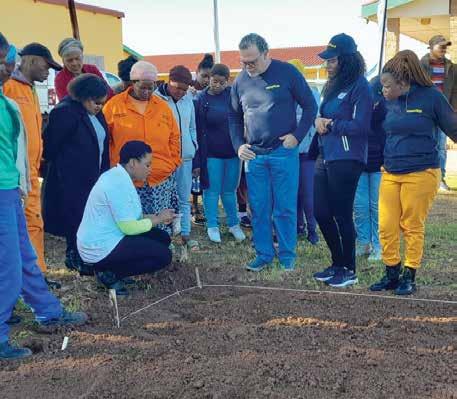
In an effort to curb food wastage, which is rife across the planet, the United Nations 12th Sustainable Development Goal (SDG) targets sustainable consumption and production to secure better access to quality resources for the growing





the scheme promotes home garden initiatives to address immediate food security needs in vulnerable communities. Overall, ACFS works with 17 000 women and youths across eight areas.
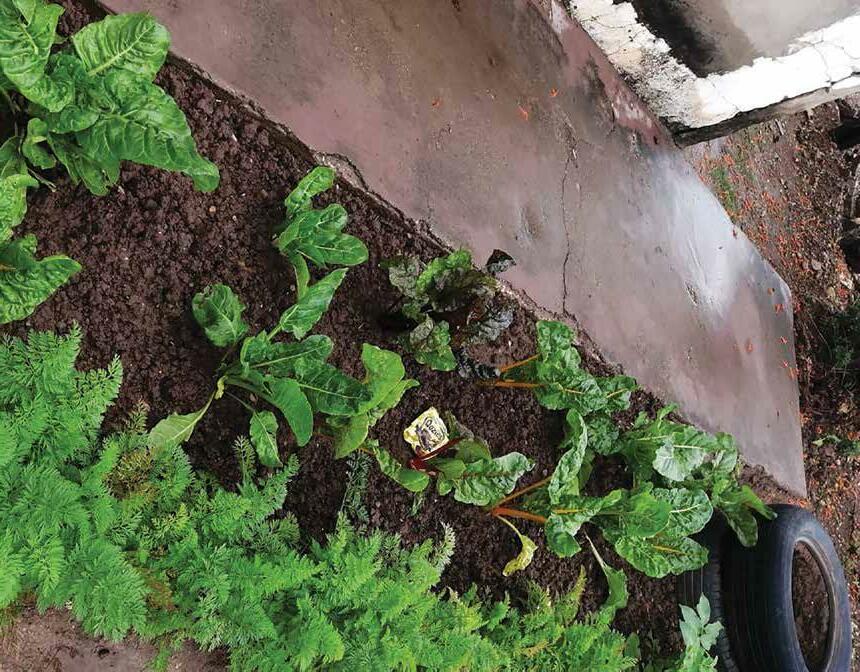
‘We support the scheme through a programme of payroll giving, a simple and effective way for a company and its employees to support worthy causes,’ says Poovi. ‘Our employees can be confident that their contributions are managed efficiently and will help change lives.’
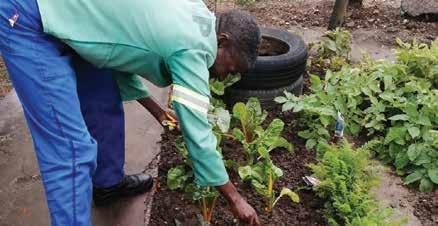
ENSURING FAIR PLAY BETWEEN SUPPLIERS AND CONSUMERS
The Consumer Goods and Services Ombud is a part of the fast-moving consumer goods industry value chain, providing impartial and independent dispute resolution.
By the CONSUMER GOODS AND SERVICES OMBUD
WHO WE ARE
The Consumer Goods and Services Ombud (CGSO) is an impartial, independent dispute resolution scheme. We serve as a mechanism for the industry to manage its own disputes rather than referring every unresolved customer complaint to the National Consumer Commission (NCC) for investigation.
The cornerstone of our dispute resolution process is the Consumer Protection Act (CPA) and the Consumer Goods and Services Industry Code of Conduct. This was promulgated by the Minister of Trade and Industry on 29 April 2015, making it mandatory for all qualifying businesses to participate in the scheme.
The GCSO is run as a not-for-profi t organisation and is funded through annual participation fees based on a percentage of annual turnover. Small, medium, macro and micro enterprises join free of charge. By signing up, participants commit to adhering to ethical practices, reassuring consumers that they may trade with confi dence.
CGSO is governed by a board of directors comprised of industry, consumer bodies, and independent representatives. Although the board comprises industry representatives, directors play no role in the adjudication of complaints, ensuring that complaints are managed independently without the infl uence of industry. We pride ourselves on our excellent governance and have reported eight clean audits every year since we have been in existence.
WHAT WE DO
We receive and assist in resolving consumer complaints against members (participants) of the consumer goods and services industry in terms of the CPA and enforce the Industry Code of Conduct.
We only take on consumer complaints after all internal customer complaints processes have been exhausted, allowing businesses to resolve outstanding issues before we become involved. Participants can also refer diffi cult cases to the Ombud instead of litigating and risking brand and reputational damage. These services are provided at no cost to the consumers and at no additional cost to paidup participants.
WHO MUST REGISTER
The code applies to all retailers, suppliers, wholesalers, distributors, manufacturers, producers, importers, intermediaries, logistics and supply chain agents in the fast-moving consumer goods industry unless regulated elsewhere by public regulation or a Code of Conduct accredited in terms of section 82 of the CPA.
Currently, the only other accredited code is the Motor Industry Code of Conduct. Failure to comply with the code is a breach of the CPA. Participants must display a decal on storefronts (where applicable), in their complaints’ departments, and on their websites.
Apart from signalling compliance with the code, advertising their affiliation to the CGSO serves as a commitment to customer service and an

indicator that consumers can transact secure in the knowledge that they will receive fair and reasonable treatment if anything goes wrong.
In terms of the CGSO Code, participants must contribute to funding the CGSO’s operations by paying a joining fee, an annual levy, and (if necessary) a special levy, as determined from time to time by the board of the CGSO, based on annual turnover.

WHY SHOULD YOU REGISTER
By signing up to the scheme, you are ensuring that your brand receives the following competitive advantages:
• Compliance with the CPA sends a powerful message to consumers.
• Unlimited access to an independent professional body to mediate customer complaints and disputes relating to the Code or CPA.
Additionally, the CGSO is part of the industry value chain by:
• Facilitating unbiased, quick, and effective dispute resolution between consumers and industry members in terms of the CPA.
• Advising and guiding the industry to minimum standards when engaging with consumers.
• Collecting and analysing industry data relating to systematic and recurring problems, and making recommendations on how to resolve these issues.
• Reducing the administration burden on participants by enabling them to escalate difficult complainants to the CGSO for mediation, thereby saving time, effort and costs.
• Advocating for restorative, not punitive action against transgressors of the CPA and the code.
• Identifying ways of increasing CPA compliance through the extension of internal resolution processes.
• Providing CPA-awareness training for client-facing staff at no additional cost.
“Business owners should view us as a partner whose mission is to promote mutually beneficial relationships between them and their customers. Since 2015, we have successfully mediated 61 418 complaints, in many cases salvaging brand reputations and customer relationships in the process. We look forward to being of service to you,” says CGSO’s chief executive officer, Queen Munyai.
this QR code to go directly to the Consumer Goods & Services website.


For more information: (011)
www.cgso.org.za
IMAGES: SUPPLIED 12 WORLD FOOD DAY ➔ Scan
781 2607
ADVERTORIAL CONSUMER GOOD & SERVICES OMBUD
Land tenure key to addressing food insecurity
South Africa has fallen behind in making land available for agricultural production. BUSANI BAFANA ponders what can be done
Commercial agriculture is largely responsible for South Africa’s food production, where maize and wheat enjoy monoculture status.
The South African Vulnerability Assessment Committee indicates that agricultural production from the small-scale farming sector is too low to sustain households with food adequately. Furthermore, only 17.2 per cent of South African households are involved in some sort of agricultural production, according to the 2021 General Household Survey.
However, research shows that to bring about greater food security, land tenure plays a greater role than commercial food production.
Dr Jemina Moeng, chief director of food security at the Department of Agriculture, Land Reform and Rural Development (DALRRD), believes that land tenure is critical in supporting food security, but admits that South Africa has fallen short in availing arable land for agricultural production. “South Africa’s land reform programme is widely considered to have failed over the last two decades, with over 80 per cent of

beneficiaries unable to build an agricultural surplus or productive capacity.
“Land tenure is critical for consistency in food production and continuous supply of food for households. Those involved in agricultural production have better access to food and generally experience lower levels of poverty.”
Dr Moeng adds that expansion of farmland and accelerating land redistribution is critical to strengthening the agricultural sector. “This should be one of the deliberate strategies to transform the agricultural sector in order to allow new players from historically disadvantaged backgrounds.”

Government interventions
DALRRD is furthermore working towards redressing this by supporting farmers through programmes such as the Comprehensive Agricultural Support Programme and the Presidential Employment Stimulus, which has enabled 70 000 subsistence producers to be productive.
The government has also aligned its strategies to strengthen sustainability of food systems, guided by international frameworks such as the Sustainable Development Goals and the Comprehensive Africa Agriculture Development Programme. The effectiveness of these programmes relies on rural households having access to land for increased agricultural production that is expandable to commercial level. “As such, there could be a justification of a need for expropriation of land without compensation,” says Dr Moeng.
Expropriation without ownership
Agri SA CEO Christo van der Rheede disagrees on the issue of expropriation, however, stating that progress in establishing more commercial farmers must go hand in hand with an economically viable and sustainable land reform process. “DALRRD has nearly 11 million hectares in its possession, which need to be made available to those with an appetite and aptitude for commercial farming. Currently just over 1 million hectares are being leased to farmers by the department. Land acquired by the state not being translated into full ownership or long-term leases cannot go unchallenged, because it undermines the productive use of such land.”
Van der Rheede points to Partners in Agri Land Solutions, which has been successful in showing the need for sustainable land security.
“A land-reform agenda seeking political outcomes as opposed to economic outcomes only distributes misery. A land-reform agenda seeking economic outcomes knows that critical success factors are security of tenure, ownership of land and an operational strategy based on ongoing training, sound blended financing principles, world-class extension services, access to local and global markets, and integration into organised agricultural structures.”
Tenure and welfare
Statistically, tenure security plays a big role in the welfare of an economy. The United Nations Food and Agricultural Organization (FAO) states that land rights are vital not only for securing the right to food but also as a social, economic, cultural and spiritual resource, underpinning value and power for rural households.
In a report published in 2020, the FAO notes that secure tenure incentivises the right holder to invest in, conserve and improve the land, including for food production, among other benefits. While the link between tenure security and food security is complex and relatively contextual, studies from countries where high-quality data is available, such as Ethiopia, India, Nepal and Rwanda, have shown that increased tenure security has increased food security for households.
On the other hand, in many other parts of the world, including throughout Africa and Asia, weak legal governance or enforcement of laws and policies have resulted in violations of the rights to access, use or control land, which in turn has led to severe food security insecurity and loss of livelihoods.
LAND TENURE WORLD FOOD DAY 13 IMAGES: SUPPLIED
“Land acquired by the state not being translated into full ownership or long-term leases cannot go unchallenged, because it undermines the productive use of such land.”
– Christo van der Rheede
Christo van der Rheede
Dr Jemina Moeng
FOOD SECURITY –PARTNERING FOR A PURPOSE




At Premier FMCG, we believe in earning the right to operate in our communities by being a responsible employer and producer of quality branded products that are made available to our consumers. We go to great lengths to uplift the communities in which we operate, where our employees live and where our brands are consumed.
Premier is committed to ensuring continuity of supply of staple foods to the market on a fair and equitable basis in support of the UN Sustainable Development Goal #2Zero Hunger. Premier has an established and a diverse source of supply for our key commodity inputs and continuously explores alternative sources that meet our quality requirements. Through our continuous improvement culture, we constantly seek ways to reduce the impact of increased input costs on our end consumer. The poorer communities who consume a large share of the total staple foods basket are most impacted by the increase in commodity prices and fuel.
“Food safety and security remains a priority for Premier. We will continue to minimise the impact of cost increases on the end consumer, but unfortunately, some factors are beyond our control.” Says Kobus Gertenbach, Chief Executive Officer.
Premier FMCG is a national business comprising 30 manufacturing operations and 25 distribution depots within South Africa, as well as operations in eSwatini, Lesotho, Mozambique, and the United Kingdom. The Premier Purpose is that our products and people make a difference in the everyday lives of our consumers, and to this end, we do everything we can to ensure food security in terms of safety, quality, availability, and affordability. We are constantly exploring options to make our products more accessible to those who need them.
Premier works with local communities through partnerships to support the implementation of the UN SDGs through mobilising and sharing knowledge, expertise, technology and financial resources. Since the start of the global Covid-19 Pandemic, Premier has worked with more than 700 NGOs and Charities donating food products to those who need it most, including participation in World Hunger Month, World Food Day and Mandela Day events. To date, we have donated more than 6.3 million loaves of bread, 4 270 tons of maize and wheat products, as well as Mageu and Sanitary products, valued at more than R115 million, providing approximately 18 million meals to the underprivileged within our community.
Gift of the Givers

Operating throughout South Africa and other countries providing food and medical support for disaster relief, Gift of the Givers is a long-term partner of Premier. Over the past few years, Premier has provided Gift of the Givers with over 1 900 tons of maize, confectionery and sanitary products valued at R12.5 million.
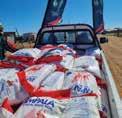
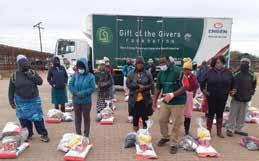
Food Forward
Operating through nine depots in South Africa, they collect and distribute a wide range of nutritional food products to communities where food is most needed and rely mostly on donations from citizens and companies to forfulled their work. Food Forward compiles and distributes grocery hampers. Partnering with Food Forward, Premier has distributed over 1 712 tons of maize.
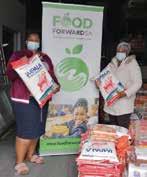
The work that these NGOs and charities do is commendable. Some of the initiatives that we have supported in the past two years include:
SA Harvest
SA Harvest rescues and redistributes surplus food to a wide range of beneficiary organisations that feed vulnerable people on a daily basis. They also develop sustainable programmes within communities to ensure long-term food security. Since the outbreak of the pandemic, more than 658 tons of maize, wheat and other products have been provided to SA Harvest for further distribution, serving more than 2 million meals through 67 charities.
Mandela Day 2022
Every year, Premier gets involved in various Mandela Day initiatives around the country. This year, some of the initiatives included:
005gnitanod • Kotas to underprivileged school children. ,erauqSalednaM • Sandton and the CTICC (Cape Town International Convention Centre). In celebration of Nelson Mandela Day, Ladies of Love made over 31 000 Blue Ribbon sandwiches and collected more than 58 000 cans of food which were distributed through more than 16 charities.
llafretaWruo • head office packed more than 500 food parcels on Mandela Day which were distributed by Food Forward.

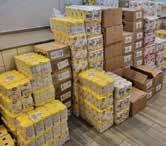
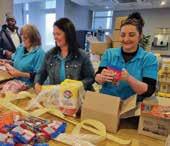
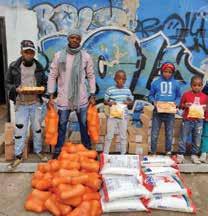
Community Feeding Programmes

,snwodkcolthgiehehtgniruD • Woodstock Breweries started serving soup to the local community. Converting our Blue Ribbon promotions vehicle into a 1 000-litre soup container, Premier and Woodstock Breweries, in collaboration with local municipalities and the mayor, we ensured that communities had access to much needed hot meals.
denoipmahc,evitaitiniseraCtoH • by Hot102.7 FM, Blue Ribbon donated a total of 21 320 loaves providing 191 880 meals over the past two years.
seitirahcrellamseromynamdnA
• within the communities that provided much needed food security to vulnerable groups, be it a daily meal or disaster relief.
Education
ehtdeniojevahohw flwonS •
Bake for Profit programme to become economically viable. Working with Learn to Earn, 56% of graduates in 2021 have become self employed and 32% found employment whilst baking part-time. The skills gained through this programme will impact the lives of these women, and their communities.
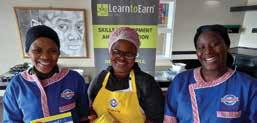
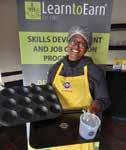
ekamdeenehthtiWseilacirfA
in education. a genuine and real difference in the lives of our employees and the communities in which we operate, we have identified crèches in the areas surrounding our bakeries that we uplift and support. To date, 174 crèches in the Eastern Cape, KZN and Gauteng have been painted, received educational materials and bread donations to assist in nutrition and learning.
OGNmorf
Zero2Five Trust, Nyala provided 2 496 meals for children in 44 early development centres and upgraded nine centres with toilets, fencing, roofing, playground equipment as well as puzzles, play mats and toys.
dnettaoohcssuoirav
a two-day entrepreneurship holiday camp run by Dot.Good and our Eastern Cape bread brands, namely Mister Bread and Star Bakeries. The children who attended the holiday camp, as well as the schools in their communities received more than 5 830 loaves of bread.


htuoS •
ecnatsissa •
•
Home gardens reduce hunger, but progress is absent
Millions of South Africans rely on subsistence farming to supplement their food supplies. HAMLET HLOMENDLINI, senior agricultural economist specialist at Absa AgriBusiness, asks what can be done to support them


Many people believe that South Africa’s subsistence farming sector, which is mainly dominated by black people, contributes very little to total agricultural output. That may be true, but according to a number of studies, subsistence agriculture, as the primary economic activity in many rural communities across Africa, plays a critical role in providing better livelihoods and food security for rural families.
However, it is also true and of concern that nearly three decades after the dawn of democracy, South Africa’s dualistic agricultural sector continues to be a phenomenon that the government finds difficult to address. While some progress has been made in terms of providing support that has enabled a few subsistence farmers to commercialise their production, the commercial farming sector, and indeed its supply chain, is still dominated by large agricultural operations owned primarily by white people.
As a result, according to recent studies, subsistence farmers produce less than 10 per cent of the country’s total agricultural output and play very little part in the trading of agricultural products.
Factors holding back farmers
In many instances, the output of subsistence farmers has been held back by a combination of factors. T hese factors include:
• Extremely small and fragmented landholdings
• Primitive and simple cultivation techniques, with production often taking place in home gardens due to a lack of access to proper implements and other resources
• A complete lack of modern equipment like tractors and farm inputs such as chemical fertilisers, insecticides, and pesticides
• Production is often a supplemental rather than primary source of family consumption and income
• A lack of ability to apply new production technologies critical to increasing yields
T hese factors, combined with a lack of adequate support, are contributing to subsistence farmers’ low output.
Despite these challenges, and the often marginal conditions under which subsistence agriculture is practised, it can play a vital role in minimising vulnerability to hunger in rural food-insecure households. Furthermore, the significance subsistence farmers place on this farming activity as a means of supplementing
The significance subsistence farmers place on this farming activity as a means of supplementing their food supplies appears to outweigh other reasons for engaging in farming.
their food supplies appears to outweigh other reasons for engaging in farming. This clearly demonstrates that rural communities use subsistence farming as a primary strategy to improve their livelihoods and household food security.
Partnerships for greater food security
Food security exists when all people in a society have adequate food for an active, healthy life at all times. As a broad term, food security is defined by the availability of safe and nutritious food, and a guaranteed capability to procure and acquire food of good quality in a socially acceptable way. On the other hand, food insecurity occurs when basic healthy food is not easily accessible and poor households struggle to secure enough food for their nutritional needs.
Against this backdrop, many South Africans appear to be very hungry. Studies indicate that one in every five people is living in extreme poverty, with nearly 50 per cent relying on social grants. From their inception, social grants were thought to be the best tool for addressing rural hunger and household food insecurity, but nearly 30 years on, they still fall far short of covering the basic cost of nutritious food. This is precisely why desperate communities frequently turn to subsistence farming as a means of bridging the nutritional divide.
As previously stated, the most significant barrier that completely impedes their progress is a lack of technical knowledge, lack of adequate support, and access to and slow adoption of new technology to increase productivity. In addition, the crisis is deepened even further by ongoing climate change.
It is clear that the current form of support by the government is relatively ineffective, as it does not significantly consider the rural farming context and does not attempt to support and strengthen rural farming practices or address the constraints thereof.
A ppropriate support for subsistence farmers may yield positive results through collaboration between the government and the private sector. This partnership should focus on the following three key areas: improving output quality and quantity; promoting the use of seeds and nutritious crops that require the least amount of water; and promoting the use of cutting-edge technology to improve output in order to assist capable farmers in transitioning from subsistence to more commercial and market-oriented production.
16 WORLD FOOD DAY THOUGHT LEADERSHIP – SUBSISTENCE FARMING IMAGES: IS TOCK.COM/ RIDOF R
ANZ,
SUPPL IED
Hamlet Hlomendlini
Those producing at least some of their own food have a higher chance of being food secure.
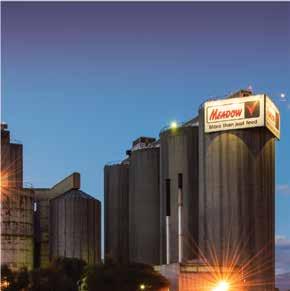
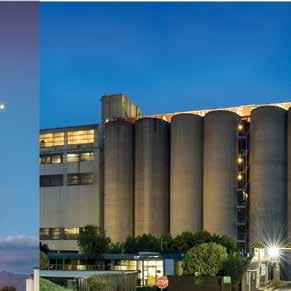
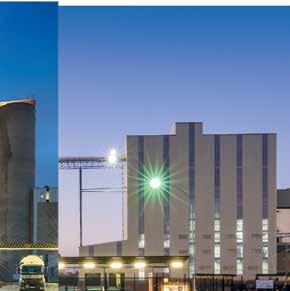
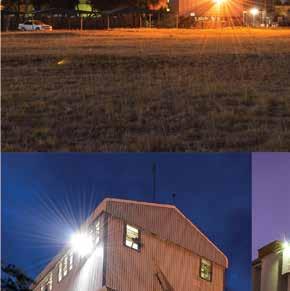




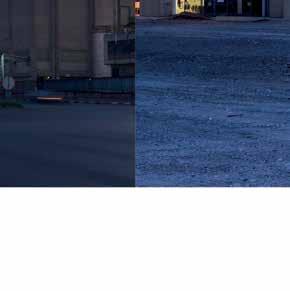





pARTNERINg FOR LONg-TERM SOLUTIONS TO RISINg FOOD INSECURITY
The National Development Agency (NDA), in collaboration with the Human Sciences Research Council (HSRC), hosted a development policy dialogue in August. The aim was to initiate a constructive debate on two interconnected concerns, food security and vulnerable population, amplified during the COVID-19 pandemic.
The policy dialogue organised by the NDA brought together civil society, government, private sector, and academia. The focus was on development policy discourse on rising food and nutrition insecurity, which can be addressed through effective development policies that can guide long-term solutions for this phenomenon.
During the height of the pandemic, the South African government implemented multipronged interventions to mitigate the impact of a lack of food and nutrition on poor and vulnerable households and communities. In response to pandemic shocks, prioritising food access to poor and vulnerable South African families was first and foremost aimed at cushioning vulnerable households and communities. Interventions to mitigate this during the
pandemic included the distribution of food parcels, food vouchers, and various social grants to provide quick and short-term relief for vulnerable families and communities across the length and breadth of the county.

At the centre of mitigating the impact of a lack of food and nutrition on vulnerable families was the Department of Social Development (DSD) with its Agencies, NDA and SASSA. Their role is to provide the first line of defence for these families by ensuring that this population group does reach the point of famine. The dialogue was based on using the lessons from this experience to inform long-term future solutions to eradicate food and nutrition insecurity in South Africa.
“The basis to developing a productive and resilient population and communities is addressing the question of hunger, then development becomes possible,” says Bongani Magongo, acting CEO, NDA.
RESEARCH STUDY AND ITS RECOMMENDATIONS

It is against this background that the NDA conducted a research study aimed at providing a better understanding of how the social
The NDA conducted a research study aimed at providing a better understanding of how the social development sector responded to the food and nutrition needs of affected populations.
development sector responded to the food and nutrition needs of affected populations. Existing policies, programming strategies and resources during COVID-19 guided social development sector responses. The outputs of the study aim to inform the adjustments of these policies, strategies, and programming of responses during and post-COVID-19 on food and nutrition interventions. This assignment seeks to inform and improve the design of future interventions. Some of the key recommendations emanating from this research report included that there is a need for a sustainable mechanism for mobilising resources from within and outside government to complement sufficient, nutritious food parcel allocations during future emergencies such as the COVID-19 pandemic. The government needs to plan and develop better early warning and surveillance systems for precision forecasting and preparedness to respond to similar emergencies with devastating impact on vulnerable and poor households. International organisations, such as the Food and Agriculture Organisation of the United Nations and other multilateral agencies, are key to supporting the government in setting up systems, tools, and quick responses to food and nutrition during emergencies as they have experience and skills in dealing with such challenges.
“The NDA, in commemorating World Food Day, acknowledges the need for continued and stronger relations between government, civil society and business to advance food and nutrition security in South Africa. There is a need to foster stronger relations especially focusing on vulnerable groups in Africa,” Magongo concluded.
For more information: +27 11 018 5500 info@nda.org.za www.nda.org.za

images: s UPPL ie D 18 World Food day ➔
Scan this QR code to go directly to the National Development Agency website.
Celebrating World Food Day, the National Development Agency reflects on COVID-19 responses and the food and nutrition security of vulnerable population groups in South Africa
ADVERTORIAL NATIONAL DEVELO p MENT A g ENCY
Mhani Gingi Cooperative members in the Western Cape.
URBAN FARMING
South Africa has vast untapped and unused agricultural lands that mostly lie in Limpopo, KwaZulu-Natal and the Eastern Cape. These provinces are coincidently where the majority of rural households struggle to survive amid high unemployment and food insecurity, relying on government grants to put food on the table. The irony is that it is within these areas that agricultural production has the potential to scale up and feed not only the locals, but also many urban dwellers who have migrated to the cities for better opportunities.
Today, we talk about urban farming as a solution to feed people in urban cities, cultivating land in areas where land is scarce, whereas it’s in the rural areas where land is available that people are starving. There is something terribly wrong with this picture.
Enabled by technology
The concept of urban farming is merely a practice that introduces technology and innovative ways of producing food and raising livestock in densely populated areas. Urban farming has given rise to demand for greenhouses, maximising production on every square metre to
increase yields and adding heating systems to allow food to be produced during cold seasons.



Technology has enabled urban farming through the adoption and use of highly advanced mechanisation systems that enable growers to grow their crops without physically being on their farms. Irrigation systems have also advanced to the level where they are automated and can run entirely without human intervention. We can further add to this list sensors that monitor humidity, soil composition, rainfall, temperature and water pH to ensure a successful harvest at the end of the day.
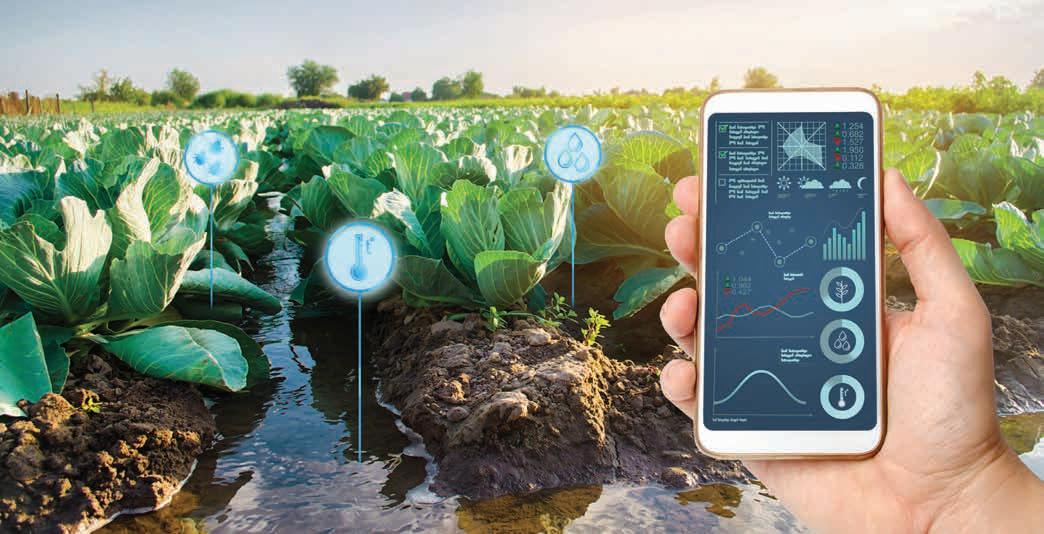
In livestock production, technology has increased livestock security through tracking devices that can trace the movement of cattle and provide an overview of the lands that are best suited for grazing in various seasons. These devices monitor animal behaviour to predict and control any outbreak of potential diseases which may lead to mortalities. All of the above are positives that have fast-tracked urban farming, and have enabled growers and producers to scale up, furthermore increasing the participation of secondary and tertiary role players across the value chain.
I believe the bigger picture we are missing here is the opportunity to bring urban farming practices to rural areas, not only to increase food security but also to create thriving economies for people residing in these areas.
Tapping untapped lands



However, these opportunities have only benefited those residing in urban areas. What about those individuals in rural communities, where food insecurity is a threat?
Farmers in rural communities, especially subsistence ones, lack access to good-quality production inputs and mechanisation systems that have the potential to help them scale their farming practices and make use of untapped lands. The potential to produce food for their communities is there, but their growth is stunted due to a lack of resources and adequate service from the sector at large.
Today, we praise commercial farmers in the sector without acknowledging that the majority of them farm within rural areas, where opportunities for locals are scarce. I believe the bigger picture we are missing here is the opportunity to bring urban farming practices to rural areas, not only to increase food security but also to create thriving economies for people residing in these areas, which will in turn positively contribute towards the broader economy.
Many of the most marginalised communities live in areas that have sufficient quality soils, rainfall and temperatures to feed both rural and urban dwellers. There is also a surplus of labour in rural communities, with skilled individuals who have a preference for raising families within their communities but who also wish to experience the same opportunities and financial rewards to which workers in urban areas are exposed.
Urban farming practices like the ones mentioned have the potential to increase agricultural production and address food security in remote areas, resurrecting rural lands that have the potential to feed the nation.


WORLD FOOD DAY 19
IMAGES: ISTOCK.COM/ ANDRII YALANSKYI, SUPPLIED
Commercial farmer MBALI NWOKO wonders if urban technology can save marginalised communities
Mbali Nwoko
THOUGHT LEADERSHIP – TECHNOLOGY
Tiger Brands initiative looks to improve child nutrition in South Africa
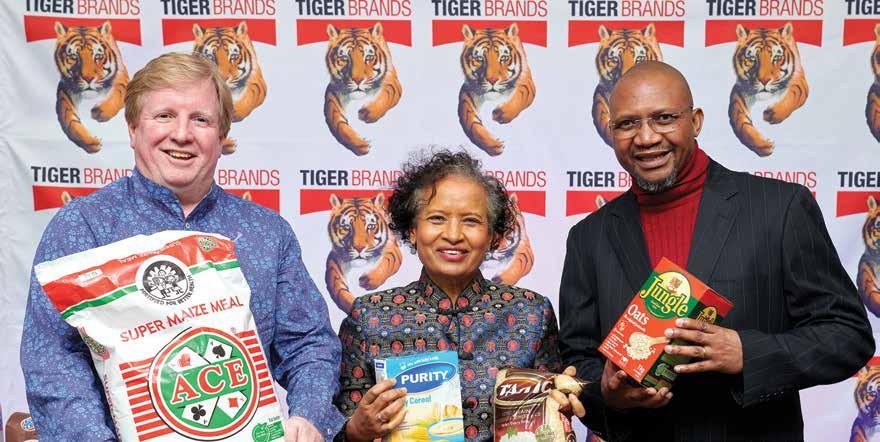
The number of hunger-related deaths amongst children five years old and under is on the rise in South Africa. Since the start of 2022, hundreds of children in this age group have succumbed to malnutrition and hunger with the biggest contributing factors being poverty and a lack of household food security.
A recent report citing research undertaken by Wits University indicated that KwaZulu-Natal is worst affected by hunger-related child deaths, followed by the Western Cape and Eastern Cape.
Tiger Brands, Africa’s largest food producer, has launched Isondlo, a child nutrition programme, in partnership with the Nelson Mandela Children’s Fund, to help address the challenge of child nutrition.
At a cost of R42-million, Isondlo will support 10 000 children aged five and under and their families, who are food insecure, with a monthly food hamper for a period of nine months.
The monthly food hamper is designed to meet the nutritional needs of these vulnerable children, together with food support for a family of four to five individuals.
The investment is over and above the 35 000 food hampers Tiger Brands distributes monthly as part of its existing food nutrition programmes. In addition to a monthly food hamper, each family receives a once-off vegetable garden starter-kit to encourage more sustainable nutrition and livelihoods. This aligns with the Nelson Mandela Children’s Fund sustainable livelihoods programme that addresses the poverty issues of the communities where children are located.
100 100 YEARS SINCE 1921
From left: Noel Doyle, Tiger Brands CEO; Dr Geraldine Fraser-Moleketi, Tiger Brands Chairman; and Dr Stanley Maphosa, CEO of the Nelson Mandela Children Fund, at the launch of Isondlo, a Tiger Brands’ Child Nutrition programme initiated to address nutrition amongst children aged five and under.
Isondlo, a child nutrition initiative implemented in partnership with the Nelson Mandela Children’s Fund
“Isondlo addresses a real need in our society – to support our future generation. We are committed to ensuring food security and sustainable livelihoods. Having marked our centenary last year, postponed due to the Covid-19 pandemic, we find the launch of the programme an appropriate way to celebrate this milestone,” says Dr Geraldine Fraser-Moleketi, Chairman of Tiger Brands.
In bringing Isondlo to life, the Nelson Mandela Children’s Fund, as Tiger Brands’ enabling partner, will utilise the networks of its 15 grassroots implementing partners in 17 districts across South Africa to identify the most vulnerable children and to distribute the food hampers over the next nine months.


Commenting on the partnership, Dr Stanley Maphosa, Interim CEO of Nelson Mandela Children’s Fund says, “The Fund has partnered with Tiger Brands as part of our Child Survival Development and Thriving Programme aimed at improving the mortality rate and the development of children under five through various interventions. Isondlo will allow us to ensure that children in this age group get the proper nutrition that they need to grow and develop optimally.”
Number of beneficiaries per province Province
Tiger Brands will not be an onlooker in the battle against child hunger in South Africa. Our children will determine what a future South Africa will look like, and we must play our part in contributing to a future where there is no child hunger. A future in which our children are resilient and can live to their fullest potential because we collectively acted when they were young.
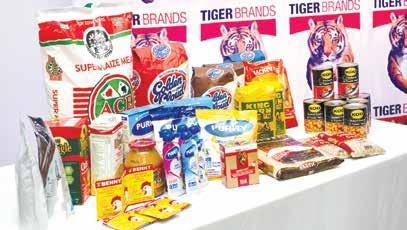 Dr Geraldine Fraser-Moleketi
Dr Geraldine Fraser-Moleketi
Beneficiaries KwaZulu-Natal 3 685 Western Cape 1 835 Eastern Cape 1 400 Gauteng 1 130 Northern Cape 600 North West 500 Limpopo 400 Mpumalanga 250 Free State 200
Looming famine requires food consumption reset
Innovation and practical interventions are needed to reduce food waste, writes COLLEEN DARDAGAN
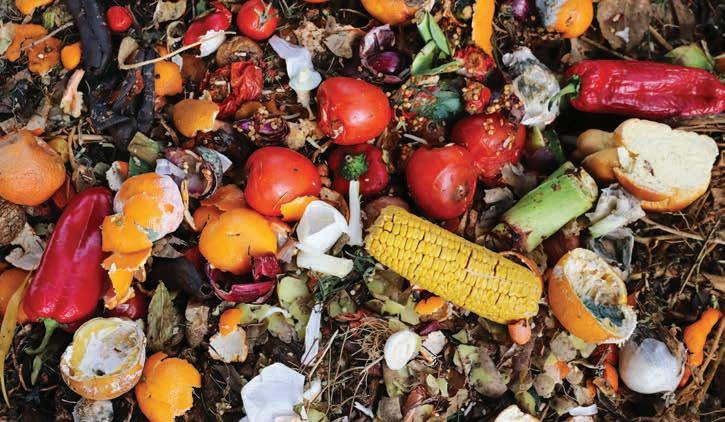
It’s estimated that globally, at least 930 million tonnes of food are wasted or lost annually, of which 61 per cent is at the household level, 26 per cent from food services (post-harvest processing) and 13 per cent from retail. This indicates that close to 20 per cent of global food production is wasted
Prof Albert Modi, deputy vice-chancellor and head of the University of KwaZulu-Natal’s College of Agriculture, Engineering and Science, says South Africa urgently needs innovation to reduce food waste and loss between farm and fork.

As most of South Africa’s food is produced by commercial farmers using sophisticated post-harvest technology, food loss in the domestic context is estimated mainly between the retailer and the household. “While the global average per capita per year is 74kg, in South Africa, the reasonable estimate of food loss in this context would be about 40kg,” says Prof Modi. “There are a range of added food-loss drivers from the commercial farm to the dinner table, which can result in at least an extra 40 per cent of a crop being rendered unsuitable for consumption, depending on whether it’s for domestic or export use. These could include delayed transport, poor storage facilities or bad on-farm practices.”
To reduce food waste on a macro level, Prof Modi says that rail and transport capabilities in the country require improvement, and the value chain should be shortened to provide space for subsistence farmers and allow for direct sales between producers and consumers.
A growing problem
A 2021 study conducted by the Council for Science and Industrial Research shows that food waste at consumption level has increased threefold since 2013, coming in at 34 per cent of local food production. Cereals contribute to the largest portion, followed by vegetables, fruit and then meat. Considering that food production would need to double in coming years to feed a growing population, solving food waste is a critical part of increasing food availability. It will also go a long way to reducing the environmental burden of farming, since the energy that is required to produce this wasted food could power Johannesburg for around 16 weeks, and the water could fill 600 000 Olympic swimming pools.
The use of a “sell-by date” on produce requires education, Prof Modi notes. “There is a difference between ‘sell-by date’ and ‘use-by date’. Encouraging consumers to buy food close to its ‘sell-by date’ while educating them on using it immediately or how to store it a little longer under low temperature conditions will help.”
Creating space for those with little or low income requires innovative thinking around the development of low-price exits for this food. “Charities and food kitchens would welcome this food and government should reward such initiatives,” says Prof Modi.
“To reduce the risk of famine, particularly in South Africa, we must encourage small-scale commercial farming backed by the development of fresh produce markets that sell directly to the consumer,” Prof Modi adds. “This will
DEFINITIONS
Food loss refers to the removal of any material that is unsuitable for human consumption from the food value chain between the producer and the retailer, but not including the retailer.
Food waste refers to elimination from consumption suitability from the point of retail to the household level.
KEY STRATEGIES TO REDUCE FOOD WASTE:
armers closer to the market.
mproved ed cation aro nd the consumption of seasonal crops.
lternative markets to take p crops rejected by retailers catering for consumers whose perception of good food is skewed by appearance.
gri-processing
development
investment
former homelands.
an end to overb ing of food by consumers resulting in
prices.
HOW TO REDUCE FOOD
IN
require investment in extension services, and the identification of drought-tolerant crops and those traditional crops that are underutilised by retailers. The recycling of food waste into compost is also a critical component of improved food supply.”
“To reduce the risk of famine, particularly in South Africa, we must encourage small-scale commercial farming backed by the development of fresh produce markets that sell directly to the
22 WORLD FOOD DAY IMAGES: S UPPL IE D FOOD WASTE
Prof Albert Modi
• bsistence
•
•
•
o non-retailable prod ce • The
o dro ght-resistant crops • grarian
in o th A frica’s
• tting
inflated
• ood rec cling
WASTE
YOUR HOME: • onl what o need • se mat re r it or smoothies juices and desserts. • tore ood wisel • nderstand ood labelling • ove o r le tovers Source: Food and Agriculture Organization of the United Nations
consumer.”
– Prof Albert
Modi
For millions of disadvantaged people already suffering hunger and poverty, climate change is a backbreaker.
Hunger has more than doubled in 10 of the world’s worst climate hotspots over the last six years. More intense and frequent extreme weather events have dealt a hard blow to millions of people already reeling from ongoing conflict, economic shocks, and rising food prices.
The climate crisis is no longer a ticking bomb; it is exploding before our eyes. Climate change is making extreme weather events, such as droughts, cyclones, and floods, more frequent and deadly. Extreme weather events have increased fivefold over the past 50 years. In January 2022, at least 14 people died in the Eastern Cape due to flash floods, and hundreds more were displaced after their homes were destroyed. The floods also destroyed roads and other infrastructure.
Eighteen million people are on the brink of starvation in the world’s 10 worst climate hot spots, which include Somalia, Kenya and Zimbabwe. The number of people suffering acute hunger has more than doubled – 21 to 48 million – in just over the past six years, according to Oxfam’s September 2022 Hunger In A Heating World, a report on how the climate crisis is fuelling hunger in an already hungry world.
South Africa is not immune to these crises. This is why Oxfam South Africa works with communities and movements in South Africa and countries in the Southern African Development Community to save and protect lives in emergencies, help people rebuild their livelihoods, and campaign for genuine, lasting change.
THE FUTURE IS EQUAL
Saving lives and building resilience are necessary prerequisites to developing a solidarity economy in the current climate and hunger crisis. In March this year, Oxfam South Africa’s Saving Lives and Building Resilience programme convened a two-day engagement between the South African Local Government Association and partners – including Zamelekhaya Tshoba, Bhaca Environmental Justice Movement, and the Eastern Cape Environmental Network – in Nelson Mandela Bay Municipality.
The engagement addressed critical issues such as community-based disaster risk and vulnerability assessments, developing and structuring municipal disaster management plans, and managing community displacement during disasters.
COMMUNITY-BASED INTERVENTION
Oxfam’s work is partner-led, and our partners’ experiences, knowledge and insights were critical to the engagement and to the building of response systems inclusive of affected communities.
The South African Local Government Association and the National Disaster Management Centre seek to improve the
state of compliance levels, operational planning, and response interventions in municipalities. Oxfam seeks to replicate critical engagements such as these among communities affected the most by climate-related disasters all nine provinces.
The Eastern Cape province has the highest rate of unemployment. Youth who have been capacitated through our work are employed at the National Disaster Management Centre and are using their skills proactively.
Oxfam South Africa’s ongoing strategic partnerships with local agencies and direct implementation aimed at building resilience have enabled the project to reach its intended beneficiary target. The project had an outreach of 14 500 people in 2022.

Through our partnership with SANAMI, Oxfam South Africa supports 64 farming co-operatives. The COVID-19 pandemic negatively impacted these co-operatives with reduced sales because many households lost their household income.
Heavy rains due to climate change have also impacted on sales.
Since February 2022, small-scale farmers of the Alfred Nzo District have been enrolled in Boxer Stores’ training programme in small business development, receiving financial support from Boxer to cover travel costs during the four months of training. The training aims to develop resilient Eastern Cape farmers to produce and supply good quality vegetables.
WORLD FOOD DAY 23
The climate crisis is no longer a ticking bomb, it is exploding before our eyes, says OXFAM
“Acute hunger has more than doubled in 10 of the world’s worst climate hotspots over past 6 years. Eighteen million of them are on the brink of starvation. Behind the climate crisis is a horrifying story of inequality.” - Lebogang Ramafoko, Oxfam South Africa, Executive Director
IMAGES : SUPPLIED
Women fetch firewood in Eastern Cape, South Africa
OXFAM “H UN G ER IN A H EATIN G W ORLD ” ADVERTORIAL
In South Africa, the proportion of people affected by moderate to severe food insecurity increased between 2019 and 2021.
According to Statistics South Africa, while all the provinces were affected, the Eastern Cape (16.6 per cent), was an exception as its food insecurity prevalence rates were below the national average (23.6 per cent) in 2020.
Families in the Eastern Cape province spend most of their income on food, and there is clear evidence of growing food insecurity as measured by the number of meals consumed and the quantity and variety of foods eaten.
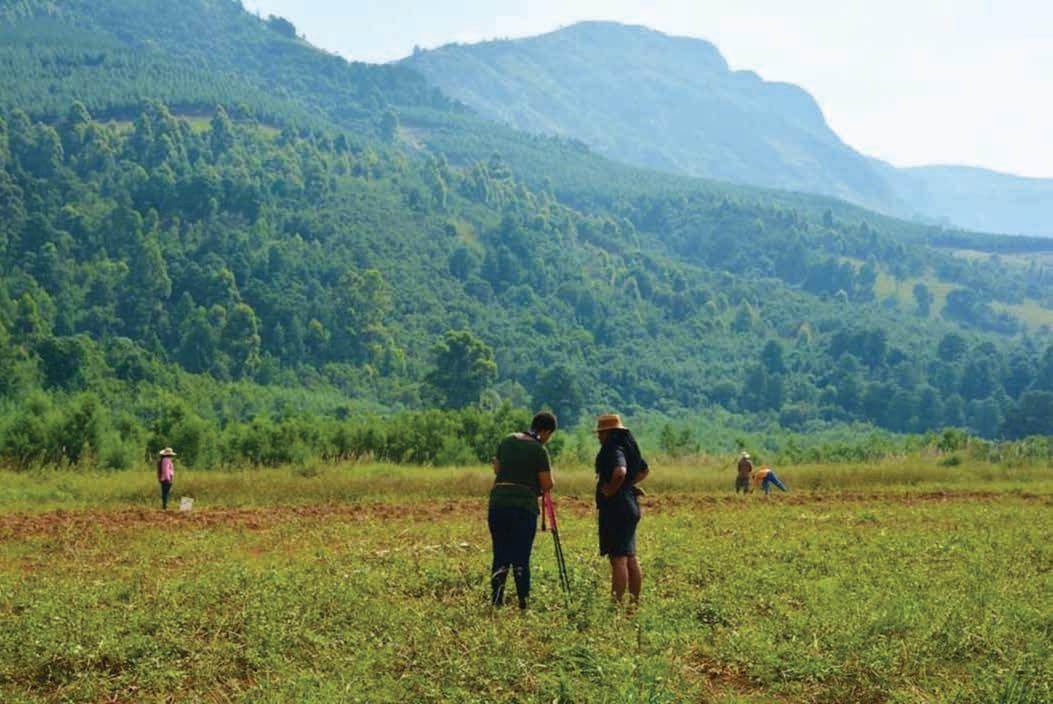
Most people in the province live in rural areas, and the contribution of agriculture to local livelihoods in the entire province is low and has been in decline for several decades. South Africa used to be the net exporter of food. Now it is the net importer.
An estimated 72 per cent of the population in the Eastern Cape province live below the poverty line, which is more than the national average of 60 per cent – this is attributable to the structural inheritances of apartheid.
EFFECTS OF UNEMPLOYMENT ON HUNGER/POVERTY
Unemployment can also negatively affect a household’s food security status.
Lockdowns triggered by the COVID-19 pandemic caused major economic disruptions and contributed to the loss of livelihoods and
POLICY, POLITICS AND POOR GOVERNANCE
The real tragedy of the devastating floods in KwaZulu-Natal in April this year is not solely due to global warming, but also to the policy, politics and poor governance fuelling hunger in an already hungry world, writes FUNDISWA NDLELA , Rural Transformation Manager at Oxfam South Africa
income. Between 2017 and 2020, household unemployment in South Africa increased. Those most affected were female-headed households – almost half of the femaleheaded households had no employed person in 2020. High levels of joblessness have always been – and continue to be – critical contributors to poverty and inequality. For the first time since 1994, the number of unemployed people in the Eastern Cape outpaced the number of those employed in 2020/2021. This is according to a study by the Eastern Cape Socio Economic Consultation.
In the second quarter of 2022, provincially, the Eastern Cape has the highest rate of unemployment at 42.8 per cent (expanded, 51.8 per cent). Limpopo has the second highest unemployment rate at 36.3 per cent, but KwaZulu-Natal has the second highest expanded rate at 49.4 per cent.
POVERTY IS GENDERED, SEXIST AND RACIST
Women, ethnic minorities and developing countries have been hit the hardest by growing inequality during the pandemic.
Data shows that, in South Africa, more women lost their jobs than men. Black women, especially, are already the least likely to be employed in the country. During COVID-19, many women skipped meals and sacrificed for their children and family members.
In 2019, almost one in every five black Africans was affected by moderate to severe food insecurity, followed by Coloureds at 16.1 per cent, while Indians/Asians and Whites were the least affected affected, according to the study.
Poverty is gendered and racist because it affects black women and children the most.
Oxfam South Africa supports the call for a feminist government, with policies informed by intersectional analyses of women’s social,
24 WORLD FOOD DAY
Mr Mjoli Lindela’s Cooperative, Lugelweni Location, Mount Ayliff, Eastern Cape
ADVERTORIAL OXFAM “H UNGER IN A H EATING W ORLD ”
oppressed groups are represented in all decision-making on matters that impact them.
CLIMATE AND HUNGER
People living in poverty are most affected by crises. The low level of public discourse around climate change as a social justice issue stymies discussions about the lack of preventative systems and mechanisms to mitigate the impact of climate-related crises, especially on poor marginalised communities working the land.
In April 2022, severe flooding and landslides were caused by heavy rainfall in southern and southeastern South Africa, particularly in the
KwaZulu-Natal and Eastern Cape provinces. The floods caused the death of 448 people, displaced over 40 000 people and completely destroyed over 12 000 houses. This is according to the European Commission’s Directorate-General for European Civil Protection and Humanitarian Aid Operations.
The real tragedy of the devastation of the floods is not solely due to the effects of global warming, but also to policy, politics, poor governance, and lack of regular infrastructural maintenance. System change is critical to mitigating the impact of hunger in a heating world.
political and economic positioning, policies that ensure women, racialised and other
SAVING LIVES, BUILDING RESILIENCE
MRS NQOKO, NTABANKULU, EASTERN CAPE
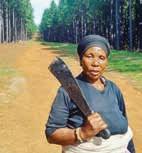
In March 2022, Oxfam South Africa visited the Eastern Cape woman farmer of the year, Mrs Nqoko. The organisation supported her with training, seedlings, and irrigation equipment. Her co-operative is directly affected by climate change. The latest crop of cabbages - rotted from overexposure to the sun and the deluge of the March 2022 oods - cannot be sold to Boxer Stores, her regular customer.
MR ZAMELEKHAYA TSHOBA, NTABANKULU, EASTERN CAPE
Oxfam South Africa visited the Tshoba family in Ntabankulu in April 2022. This family, like many others, has been affected by disaster and intergenerational poverty and pushed to acute hunger. The Tshoba family has applied for indigent status with the Municipality of Ntabankulu.
BOXER STORES TRAINING PROGRAMME
Since February 2022, Oxfam South Africa’s partners – small-scale farmers of the Alfred Nzo District in the Eastern Cape – have enrolled in the Boxer Stores training programme designed to build their capacity to produce vegetables that meet minimal standards.

Cabbage is the most consumed vegetable in the Eastern Cape, which has increased both the demand and the supply chain. However,
transporting produce remains a critical obstacle for small-scale farmers due to the geographic spread and location of their farms. Most framers must secure their own transport, and often the vehicles are not refrigerated.
The Alfred Nzo District has also experienced heavy rainfall in the past 10 months. This disaster has resulted in the massive loss of produce – cabbages, in particular. Damaged produce cannot be sold as it does not meet minimum standards for the market.
Climate change continues to signi cantly impact rural communities. Recognising this, Oxfam South Africa is working on creative ways to support small-scale farmers so that the cycles of oods and drought do not affect their production and livelihoods.
Oxfam is working with partners to introduce greenhouse technology to build farmers’ capacity to produce high-quality produce, while using less water. This will enable planting of vegetables in a controlled, safe, and sustainable environment, mitigate the impact of climate change, and support farmers to adapt to a green economy.
Oxfam South Africa will also supply the farmers with seedlings, environmentally-friendly pesticides, and tools.
DONATE TO OXFAM
Oxfam works with partners, allies and communities to save and protect lives in emergencies, help people rebuild their livelihoods, and campaign for genuine, lasting change.
Help us to save lives, and build resilience and an equal future. Your support will enable Oxfam South Africa to continue doing its work.
Oxfam South Africa is a South African Revenue Service approved Public Benefi t Organisation (PBO 930 048 899 and NPO 153-684).

Donations over R100 per tax year may qualify to receive a section 18A tax certifi cate. Applicable to South African citizens only. Make your donation via our website or EFT:
Bank name: First National Bank Account number: 62528168041 Branch code: 251345
Reference: Name + Number
For more info regarding donations, please contact: Masana Shikwambane on 011 100 4610 or email fundraising@oxfam.org.za
Scan this QR code to go directly to the Oxfam website.

For more information: 011 100 4610 info@oxfam.org.za www.oxfam.org.za OxfamSA oxfamsa oxfamsa

WORLD FOOD DAY 25
“Women, ethnic minorities and developing COUNTRIES HAVE BEEN hit the hardest by growing inequality during the COVID-19 pandemic.”
IMAGES: SUPPLIED
Nolitha Msuthu Mbizana, small-scale farmer in the Winnie Madikizela-Mandela Municipality, Eastern Cape
Nolungile Makaula
OXFAM “HUNGER IN A HEATING WORLD” ADVERTORIAL ➔
From farm tofork and everything in between.

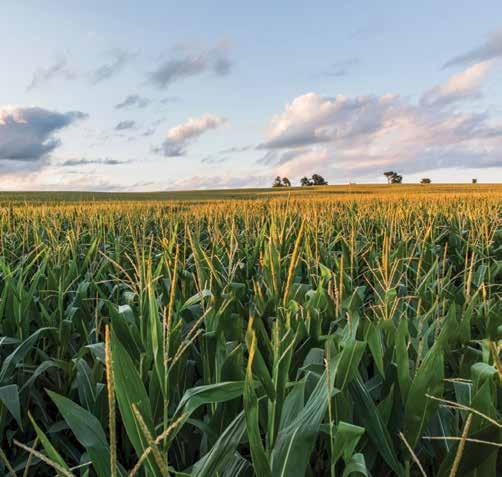
way
Trust
The


The experience

728979 OSFF
SYSPRO SUPPLY CHAIN MANAGEMENT FOR FOOD AND BEVERAGE The
the flow of goods, data, information, and finance is managed — from procurement of the produce or ingredients, to the timeous delivery of the end-product to the customer’s satisfaction — determines a food and beverage manufacturer’s level of success.
SYSPRO’s secure and efficient ERP solution for Supply Chain Management, backed by over 40 years of industry-specific expertise, to give you the recipe for success along every step of your supply chain journey.
control you need.
you want. V01 Copyright © 2022 SYSPRO. All rights reserved. All brand and product names are trademarks or registered trademarks of their respective holders. For more information call 011 461 1000 or visit za.syspro.com
SYSPRO EMEA @SYSPRO_Africa
IGIC, S UPPL
Red meat’s burning question: Can we go without?
Dairy and red meat have become pariahs among carbon-conscious consumers, since the animals from which we source them are responsible for around 12 per cent of global greenhouse gas emissions. Yet, when it comes to food security, animal protein holds the key, and much of the world’s population needs to increase their intake if they are to prosper.
Prof Alice Stanton, director of human health at the Royal College of Surgeons in Ireland, states that the correct portions of meat and dairy alongside fruit and vegetables is the best diet to ensure optimal nutrition. “Too much animal protein is not good, but so is too little.”
She acknowledges the hype surrounding shunning animal protein, stating that solid research should be used as the deciding factor. “Much of this hype originates from groups concerned about animal welfare or the environment. But a lot also comes from the plant-based, ultra-processed food industry.”
For reference purposes
Much of the hype has also been the result of the EAT-Lancet Commission Reference Diet that was published in 2019, touted as a diet for planetary health. It calls for a 50 per cent reduction in global consumption of red meat and sugar, and a more than 100 per cent increase in nuts, fruits, vegetables and legumes, by 2050. The suggested intakes equate to 14g of red meat, or 28g of poultry or fish per day.
There has been much talk about the earth’s ability to keep producing animal protein, with most arguments in favour of vegan diets. LINDI BOTHA asks if this is really sustainable
T he study has been criticised for focusing on diet’s role on the environment, rather than the body. Prof Stanton notes the complexity of food security: “We face a triple burden of malnutrition. Out of 7.5 billion people, 1.9 billion are obese, 850 million are chronically undernourished, and 2 billion suffer from hidden hunger. The latter is where dietary quality is inefficient, protein consumption is low, and diets lack essential amino acids that come from animal protein.”
Looking at the role of red meat consumption in health, Prof Stanton states that in 2017, dietary risks were responsible for 22 million deaths and for 955 million disability adjusted life years (DALYS). The latter doesn’t cause death, but increases healthcare costs. Of the deaths and DALYS, less than 0.1 per cent and 1 per cent respectively were attributed to excessive red meat and processed meat intakes. Instead, the biggest culprits are high calorie and sodium diets, and diets low in whole grains.

While the EAT-Lancet report shows that their diet results in 11 million fewer deaths associated with this style of eating, Prof Stanton clarifies that the longevity does not come from a reduction in red meat, but rather an improvement in the diet quality, which
MEAT COUNTS
A study conducted in Kenya to measure the effect of diet on test scores of seven-year-old Kenyan school children revealed:
receiving meat additions scored 45 points out of 350 points higher;
receiving milk additions scored 26 points more;
receiving plant-based meals scored five points lower; and

receiving no additional school meals at all scored 20 points lower.
drastically reduces the intake of calories, sodium and highly processed foods. “If we only point at red meat, we are going after the wrong target.”
A glass of milk a day...
T he ongoing Prospective Urban Rural Epidemiology study, conducted to ascertain the factors that lead to obesity, found that a lack of dairy actually causes deaths and DALYS. Two full-fat servings of dairy per day are associated with 32 per cent fewer cardiovascular events and 25 per cent lower mortality.
Global meat consumption stands at 50g per day for high-income countries, and less than 10g per day for low-income countries.
“Vegetarian and vegan diets adversely impact bone, brain and blood health, resulting in anaemia, osteoporosis, hip fractures and elderly sarcopenia,” says Prof Stanton. “In children we see stunting and brains that are not properly developed.” She says that while leading a healthy life on a vegan diet is possible, it requires a careful balance of additional mineral and vitamin supplements – something that poor populations can hardly afford.
To solve the environmental and animal welfare dilemma that animal protein consumption presents, Prof Stanton points to the plethora of research and new farming systems that are emerging to solve these issues, hopefully resulting in greater food security for all.
SU S TAINABLE DIET S WORLD FOOD DAY 27
IMAGES: ISTOCK.COM/ DRAZEN Z
IE D
• Those
• Those
• Those
• Those
Source: Animal Source Foods & Primary School Test Scores of Kenyan School children, British Journal of Nutrition, 2014
Prof Alice Stanton

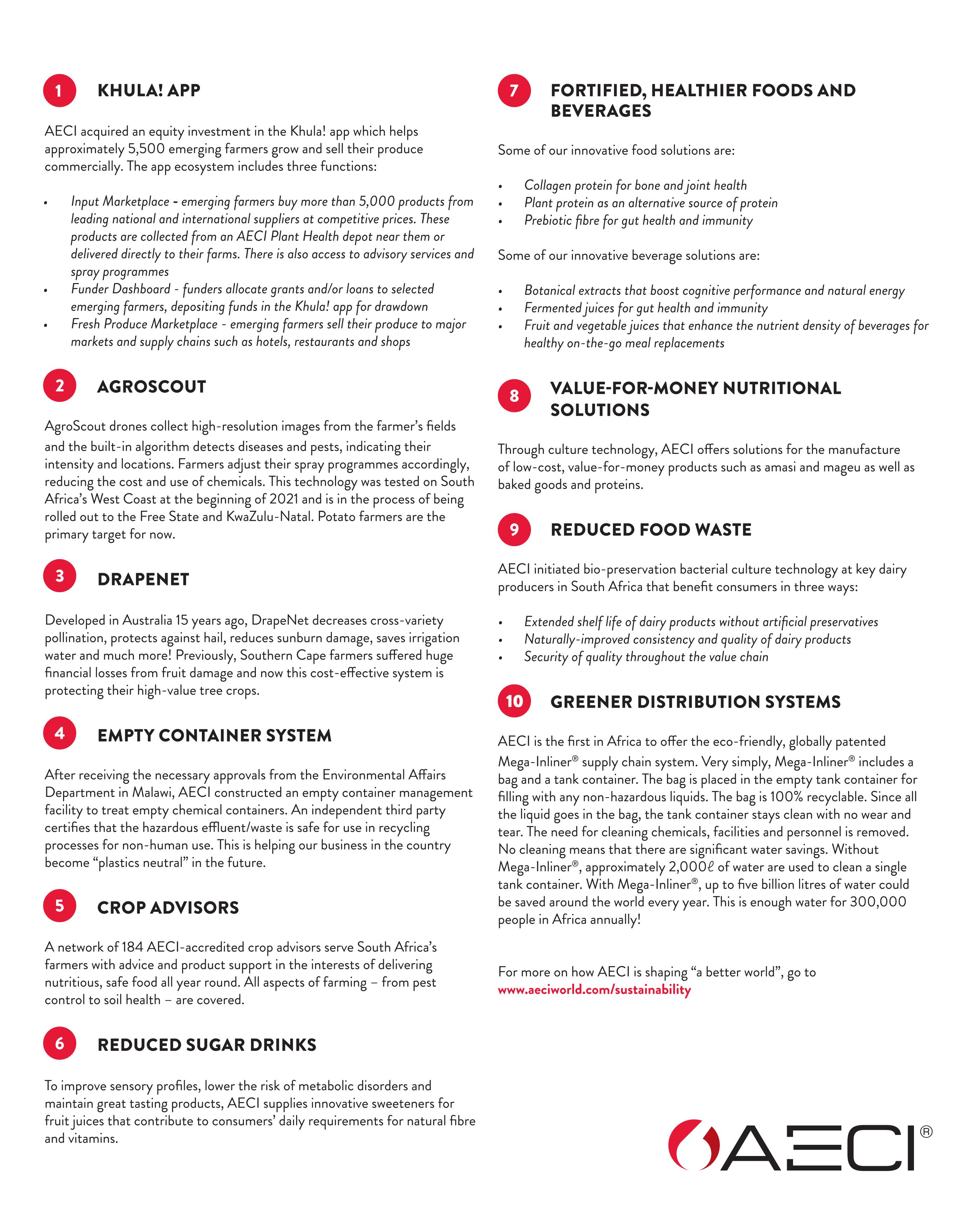
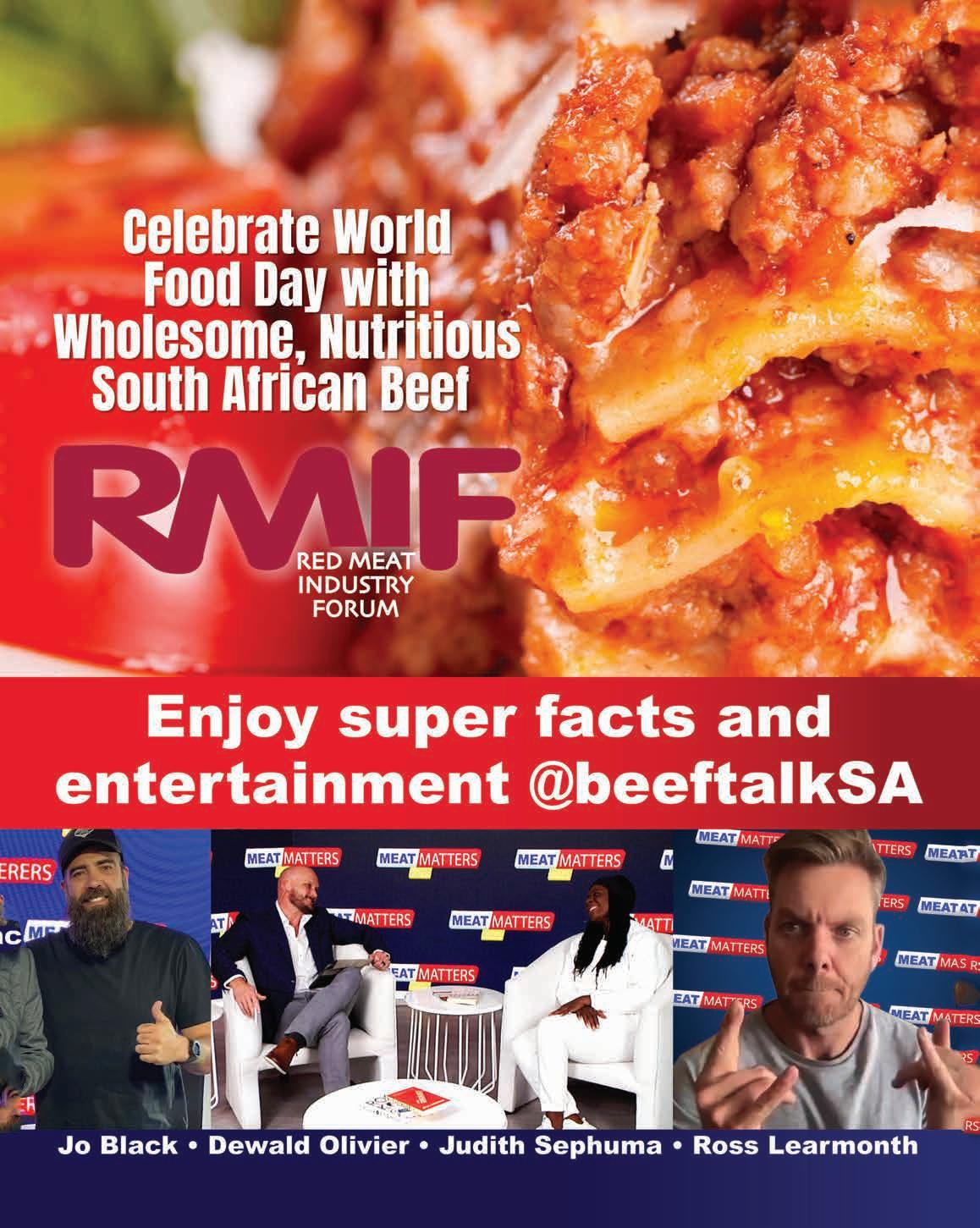













































Published in March 2023 To advertise in Human Rights Day 2023 please contact, Jerome van der Merwe Sales Project Manager (021) 469 2400 | (021) 469 2485 | 082 668 1496 www.businessmediamags.co.za JeromeM@picasso.co.za Publisher PUBLISHER PICASSO HEADLINE, A PROUD DIVISION OF ARENA HOLDINGS (PTy)LTD. Hill on Empire 16 Empire Road (cnr Hillside Road), Parktown, Johannesburg Postal Address: PO Box 12500, Mill Street, Cape Town, 8001 21March2020 NEVER STOP ADVOCATING FOR HUMAN RIGHTS HumanRights_FinalCover.indd 1 2020/03/12 2:30 PM 21 March 2021 PROTECTING OUR HUMANITY www.businessmediamags.co.za HumanRights_Cover2021.indd 1 11.03.21 18:10 21March2022 www.businessmediamags.co.za CREATING ACTIVE CITIZENRY HONOURING ONE OFSOUTH AFRICA’S MOST RESPECTEDLEADERS,THELATE ARCHBISHOP DESMOND TUTU. Page6 HR_Cover.indd 2 2022/03/09 8:54 AM
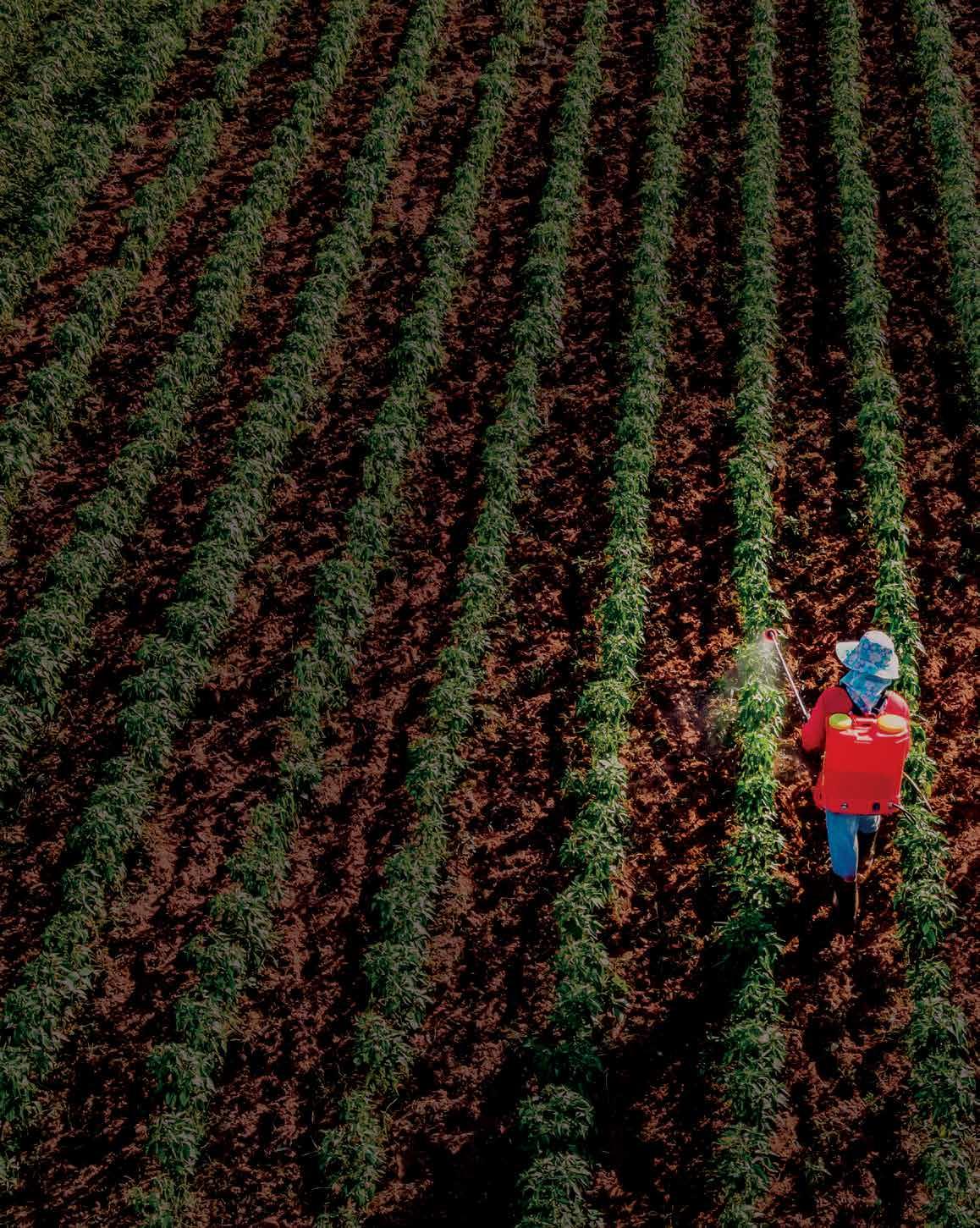






























































































 Dr Geraldine Fraser-Moleketi
Dr Geraldine Fraser-Moleketi






































